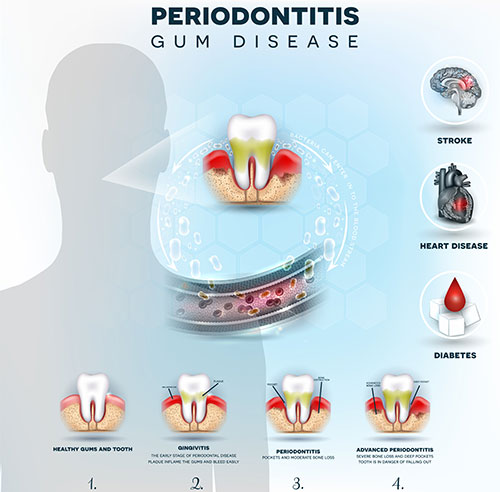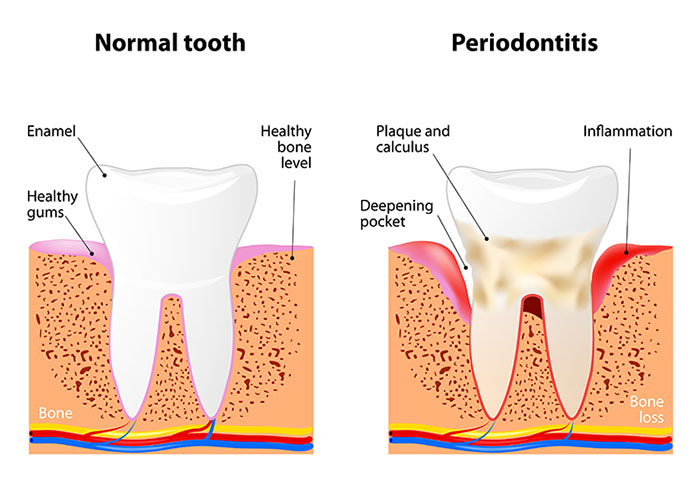
Gum Disease
Symptoms of Gum Disease
Healthy gums are firm and fit comfortably around teeth. Unfortunately, when gum disease develops, the gum tissue pulls away from the teeth. Ultimately, the tissue and bone that support the teeth are damaged, which leads to gums that can no longer support teeth. Consequently, tooth loss occurs.
Gum disease usually comes with a host of symptoms such as swollen, puffy, bright red, and/or purple gums, gums that are tender to the touch, bleed easily, pull away from their teeth, and/or make their teeth appear longer than usual. Additionally, gum disease causes bad breath, loose teeth, spaces between teeth, and even pus.
Types of Gum Disease
The most common type of gum disease is chronic. Chronic gum disease is caused by plaque and occurs via a slow deterioration of the gums. Untreated, this condition can lead to serious consequences for gums/bone.
Aggressive gum disease is not as common and typically begins in childhood or early adulthood. Untreated, it may cause rapid bone and tooth loss.
Necrotizing gum disease is characterized by rapid periodontal destruction by way of soft tissue necrosis and bone loss. Risk factors for necrotizing gum disease include immunocompromised patients, vitamin deficiencies, smoking, poor oral hygiene, and severe emotional or psychological stress.
Causes of Gum Disease
Unsurprisingly, the mouth contains a variety of different types of bacteria. In most cases, gum disease occurs because of improper oral hygiene, which allows bacteria to remain in the teeth’s pockets at or below the gum line. The bacteria, mucus, and other particles in the mouth come together to form plaque, which often gets trapped in these pockets. Other causes of gum disease include illnesses, hormonal changes, certain medications that affect oral health, smoking, genetics, and poor oral hygiene, such as failing to brush and floss every day.

Diagnosing Gum Disease
Gum disease can be discovered during a routine dental checkup. A dental professional during an examination can examine a patient’s gums, search for signs of inflammation, and even use something called a probe to measure pockets around teeth. Further, X-Rays can be used to look for bone loss.

Candidates for Gum Disease Treatment
Upon receiving a diagnosis of having gum disease, patients should contact a periodontal professional and take care of the problem. Gum disease does not get better with time. The sooner patients treat their condition, the more likely that the treatment will be successful. In some cases, gum disease can actually be reversed.
Non-Surgical Treatments for Gum Disease
There are a number of gum disease treatments that do not require surgery. Ideally, non-surgical treatments are sought if the gum disease has been caught early and there is a good chance of reversal. Every patient is different though and each patient needs to be evaluated on a case by case basis.
Periodontal Bacteria
A professional cleaning is designed to remove destructive plaque from a patient’s teeth. For some patients, Dr. Dianati may suggest more than two professional dental cleanings a year so that bacteria levels can be kept minimal and with the hope that gum disease can be reversed.
Another key non-surgical treatment that is sought is called scaling and root planing. Scaling and root planing involves scraping away plaque from above and below the gum line, i.e., scaling, and smoothing out the rough areas on the roots of the teeth, i.e., planing. This techniques can be used when the gum disease has spread from the gums to the jawbone and further to the roots of the teeth.
Surgical Treatments for Gum Disease
1. Flap Surgery
- During flap surgery, the gums are lifted back and the plaque/tartar is carefully removed. The gums are then placed back in a way that allows the tissue to fit comfortably around the teeth. The purpose of flap surgery is to decrease the space between the gums and teeth, thereby reducing the areas where bacteria can grow.
2. Osseous Surgery
- During an osseous dental procedure the harmful bacteria is removed, the bone smoothened out from any damage, and your gum tissue will be properly reattached to tighten up any loose pockets around your teeth.
3. Bone Grafting
- Bone grafting is the most common surgical treatment for gum disease. Bone grafting involves using bone fragments to replace any bone that has been destroyed by gum disease. Bone grafting is meant to encourage natural bone regrowth to bring stability around to the anatomy around the tooth.
4. Gum Grafting
- A gum graft (also referred to as a gingival graft or augmentation) is a name for several surgical periodontal procedures whereby grafted oral tissue is used to cover an exposed tooth root surface.
- Acellular Dermal Matrix Allograft (AlloDerm). AlloDerm uses donated soft tissue that is a great alternative to using a patient’s own gum tissue. By using AlloDerm, a patient will not require an extra procedure to extract tissue for the actual gum grafting procedure. AlloDerm is used routinely in dentistry and across other health and cosmetic practices.
Call our office today at 818-584-1841 for a consultation to review saving your teeth.
